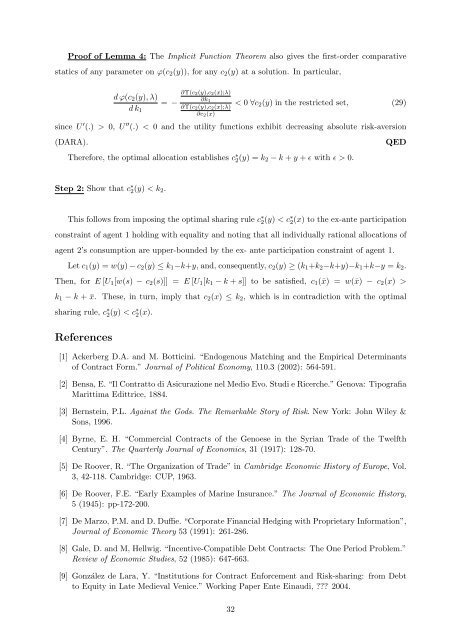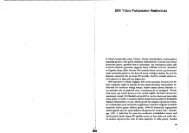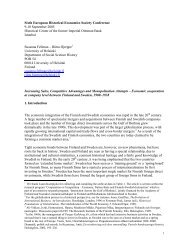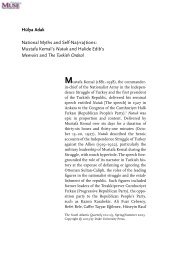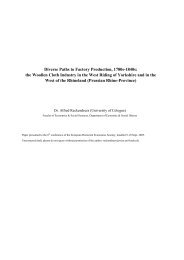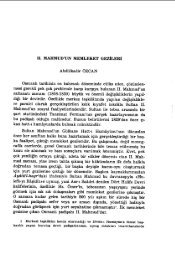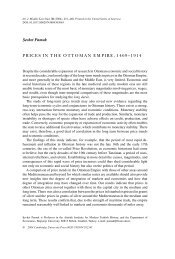The Birth of Insurance Contracts - The Ataturk Institute for Modern ...
The Birth of Insurance Contracts - The Ataturk Institute for Modern ...
The Birth of Insurance Contracts - The Ataturk Institute for Modern ...
Create successful ePaper yourself
Turn your PDF publications into a flip-book with our unique Google optimized e-Paper software.
Pro<strong>of</strong> <strong>of</strong> Lemma 4: <strong>The</strong> Implicit Function <strong>The</strong>orem also gives the first-order comparative<br />
statics <strong>of</strong> any parameter on ϕ(c2(y)), <strong>for</strong> any c2(y) at a solution. In particular,<br />
d ϕ(c2(y), λ)<br />
d k1<br />
= −<br />
∂Υ(c2(y),c2(x);λ)<br />
∂k1<br />
∂Υ(c2(y),c2(x);λ)<br />
∂c2(x)<br />
< 0 ∀c2(y) in the restricted set, (29)<br />
since U ′ (.) > 0, U ′′ (.) < 0 and the utility functions exhibit decreasing absolute risk-aversion<br />
(DARA). QED<br />
<strong>The</strong>re<strong>for</strong>e, the optimal allocation establishes c ∗ 2 (y) = k2 − k + y + ɛ with ɛ > 0.<br />
Step 2: Show that c∗ 2 (y) < k2.<br />
This follows from imposing the optimal sharing rule c∗ 2 (y) < c∗2 (x) to the ex-ante participation<br />
constraint <strong>of</strong> agent 1 holding with equality and noting that all individually rational allocations <strong>of</strong><br />
agent 2’s consumption are upper-bounded by the ex- ante participation constraint <strong>of</strong> agent 1.<br />
Let c1(y) = w(y) − c2(y) ≤ k1−k+y, and, consequently, c2(y) ≥ (k1+k2−k+y)−k1+k−y = k2.<br />
<strong>The</strong>n, <strong>for</strong> E [U1[w(s) − c2(s)]] = E [U1[k1 − k + s]] to be satisfied, c1(¯x) = w(¯x) − c2(x) ><br />
k1 − k + ¯x. <strong>The</strong>se, in turn, imply that c2(x) ≤ k2, which is in contradiction with the optimal<br />
sharing rule, c ∗ 2 (y) < c∗ 2 (x).<br />
References<br />
[1] Ackerberg D.A. and M. Botticini. “Endogenous Matching and the Empirical Determinants<br />
<strong>of</strong> Contract Form.” Journal <strong>of</strong> Political Economy, 110.3 (2002): 564-591.<br />
[2] Bensa, E. “Il Contratto di Asicurazione nel Medio Evo. Studi e Ricerche.” Genova: Tipografia<br />
Marittima Edittrice, 1884.<br />
[3] Bernstein, P.L. Against the Gods. <strong>The</strong> Remarkable Story <strong>of</strong> Risk. New York: John Wiley &<br />
Sons, 1996.<br />
[4] Byrne, E. H. “Commercial <strong>Contracts</strong> <strong>of</strong> the Genoese in the Syrian Trade <strong>of</strong> the Twelfth<br />
Century”. <strong>The</strong> Quarterly Journal <strong>of</strong> Economics, 31 (1917): 128-70.<br />
[5] De Roover, R. “<strong>The</strong> Organization <strong>of</strong> Trade” in Cambridge Economic History <strong>of</strong> Europe, Vol.<br />
3, 42-118. Cambridge: CUP, 1963.<br />
[6] De Roover, F.E. “Early Examples <strong>of</strong> Marine <strong>Insurance</strong>.” <strong>The</strong> Journal <strong>of</strong> Economic History,<br />
5 (1945): pp-172-200.<br />
[7] De Marzo, P.M. and D. Duffie. “Corporate Financial Hedging with Proprietary In<strong>for</strong>mation”,<br />
Journal <strong>of</strong> Economic <strong>The</strong>ory 53 (1991): 261-286.<br />
[8] Gale, D. and M, Hellwig. “Incentive-Compatible Debt <strong>Contracts</strong>: <strong>The</strong> One Period Problem.”<br />
Review <strong>of</strong> Economic Studies, 52 (1985): 647-663.<br />
[9] González de Lara, Y. “Institutions <strong>for</strong> Contract En<strong>for</strong>cement and Risk-sharing: from Debt<br />
to Equity in Late Medieval Venice.” Working Paper Ente Einaudi, ??? 2004.<br />
32


